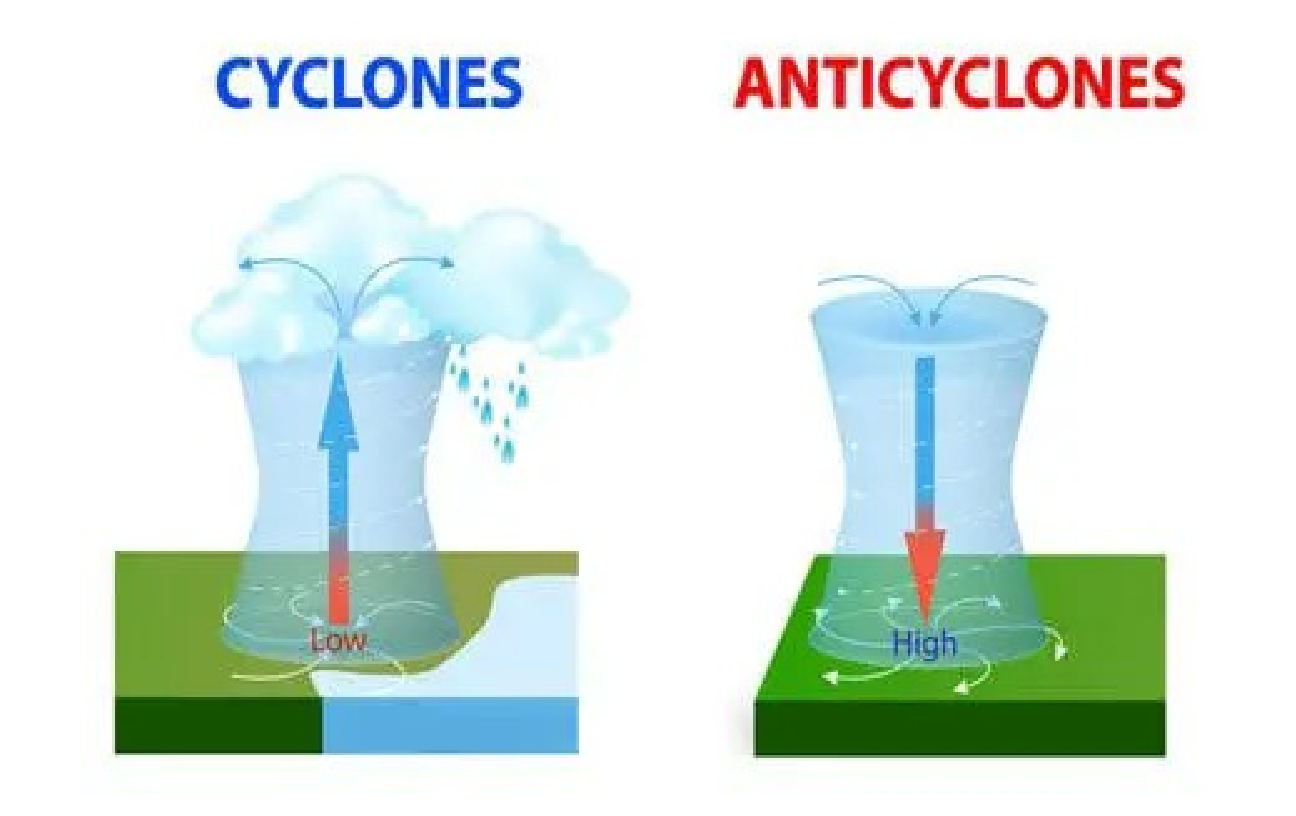Subsection 10.2.1 Winds
Winds are primarily caused by differences in temperature and pressure between different parts of Earth’s atmosphere. When air is heated, it becomes less dense and rises, creating an area of low pressure. Conversely, when air cools, it becomes more dense and sinks, creating an area of high pressure. This movement of air from high pressure to low pressure creates winds, which can be influenced by the rotation of the Earth and other factors such as the presence of mountains and oceans.
Temperature differences on the different parts of earth create the pressure difference which make air to flow. For example, the equator receives more direct sunlight and is therefore warmer than the poles, creating a temperature gradient that drives the movement of air from the equator towards the poles. This creates the global circulation patterns of the atmosphere. Local temperature differences can also create wind patterns, such as sea breezes and land breezes. During the day, land heats up more quickly than water, creating an area of low pressure over the land. The cooler, higher-pressure air over the ocean moves towards the land, creating a sea breeze. At night, the situation is reversed, with the land cooling down more quickly than the ocean and creating a high-pressure area. This causes the air to move from the land towards the ocean, creating a land breeze.
The Coriolis effect is a phenomenon that occurs due to the rotation of the Earth on its axis. It causes moving objects, including air and water, to appear to veer off course from their straight-line motion. The Coriolis effect is caused by the Earth’s rotation, which causes points on the equator to move at a faster speed than points closer to the poles. As a result, when air or water moves from one latitude to another, it appears to be deflected to the right in the Northern Hemisphere and to the left in the Southern Hemisphere. This deflection is due to the conservation of angular momentum, which causes the moving air or water to maintain its original speed and direction of motion as it moves across different latitudes. The Coriolis effect has important implications for weather patterns and ocean currents. In the Northern Hemisphere, the Coriolis effect causes air to rotate clockwise around areas of high pressure and counterclockwise around areas of low pressure. In the Southern Hemisphere, the rotation is opposite. Similarly, ocean currents in the Northern Hemisphere tend to flow to the right of their intended path, while those in the Southern Hemisphere tend to flow to the left. The Coriolis effect is also responsible for the formation of tropical cyclones, which are rotating storms that form over warm ocean waters. The rotation of the Earth causes these storms to spin counterclockwise in the Northern Hemisphere and clockwise in the Southern Hemisphere.

3
ownyourweather.com/cyclones-and-anticyclones/
Cyclones and Anticyclones Cyclones are powerful rotating storms that can form over warm ocean waters. Cyclones are characterized by their low pressure center, strong winds, and heavy rainfall. Cyclones form when warm, moist air over the ocean rises and cools, causing water vapor to condense and form clouds. As the air continues to rise, it creates an area of low pressure at the surface, which draws in more warm, moist air. This cycle of rising warm air and low pressure continues, causing the storm to intensify. In the Northern Hemisphere, cyclones rotate counterclockwise and move in a west to east direction, while in the Southern Hemisphere, they rotate clockwise and move in an east to west direction. Cyclones are commonly referred to as hurricanes, typhoons, or tropical storms when they occur over warm ocean waters. Figure 10.2.3.
Anticyclones are areas of high pressure that are typically associated with clear skies, calm winds, and dry weather. In an anticyclone, air is sinking rather than rising. As the air sinks, it warms and dries out, which leads to clear skies and dry weather. Because of this, anticyclones are often associated with calm weather conditions, such as clear skies, light winds, and dry air. Anticyclones can provide periods of stable, dry weather that is ideal for outdoor activities. However, prolonged periods of high pressure can lead to drought conditions and poor air quality due to stagnant air. In the Northern Hemisphere, anticyclones rotate clockwise and in the Southern Hemisphere, they rotate counterclockwise. Anticyclones are often referred to as high-pressure systems and are associated with stable weather conditions. Cyclones can cause strong winds, heavy rainfall, and storm surge, while anticyclones can cause calm winds, clear skies, and temperature inversions.
Tornado is a violent cyclonic storm. Tornadoes are capable of producing extreme winds, often in excess of 200 miles per hour, and can cause significant damage and loss of life. The warm, moist air near the ground rises rapidly, and the cooler, drier air aloft descends, creating a rotating updraft within the thunderstorm. This updraft can become concentrated and elongated, creating a visible funnel-shaped cloud. When the funnel cloud makes contact with the ground, it becomes a tornado. Tornadoes are typically short-lived, lasting only a few minutes, but can cause significant damage in that time. They can uproot trees, destroy buildings, and toss vehicles hundreds of yards away. Tornadoes can occur anywhere in the world, but the United States experiences more tornadoes than any other country, particularly in the central and southern regions known as Tornado Alley.
A hurricane is a tropical cyclone that occurs in the Atlantic Ocean and northeastern Pacific Ocean. It is a rotating storm system that produces strong winds, heavy rain, storm surges, and flooding. Hurricanes are classified according to their wind speed such as catagory one through five. The higher the category, the more powerful the hurricane and the more damage it can cause.
